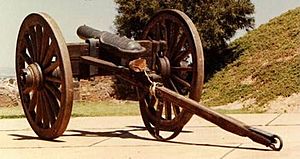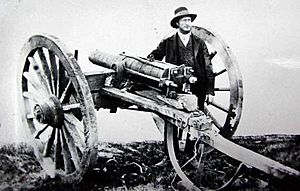Ras cannons facts for kids
The Ras Cannons were the very first cannons ever built in South Africa! These two special cannons were made during the First Boer War on a farm called Bokfontein. This was in the Brits area.
They were built in just two weeks by Marthinus Nikolaas Ras and his cousin, Eduard Dawid Ras. Marthinus is known as the "father of South African Artillery" because of his work. Eduard was a very skilled blacksmith.
In December 1880, Marthinus asked General Piet Cronjé for permission to go home. He wanted to build a cannon for the Boer forces. General Cronjé said yes!
Contents
The 'Martienie' Cannon: A Powerful Weapon
Marthinus Nikolaas Ras bought old iron wagon wheels from a seller in Rustenburg. These wheels were melted down to create the cannons.
The first cannon was named "Martienie" after Marthinus Ras himself. It was a 3-inch cannon and could fire a 7-pound lead ball. Its barrel was about 4½ feet long. During its first test, a part of the cannon called the breech plug was damaged. This meant it needed some repairs and changes.
The damaged part was replaced with a stronger one. Then, the cannon was placed on a small wagon axle with wheels.
The "Martienie" cannon was sent to the front lines. Commandant Eloff used it against the British garrison (a group of soldiers) in Rustenburg. It first fired from 2000 feet away. Later, it fired from 800 and 600 feet. Between January 8 and 9, 1881, it fired 93 shots at the British fort. This led to the fort surrendering.
The 'Ras' Cannon: A Traveling Exhibit
The second cannon was built later and was called "Ras." It was smaller than "Martienie," with a 2-inch opening. However, it had a longer barrel, measuring 5½ feet.
"Ras" was made to fire a long, bullet-shaped object. This projectile was 2 inches wide and 4½ inches long. Even with its special design, the "Ras" cannon was never used in battle during the war.
After the war, "Ras" was sent to Europe. It was shown as an exhibit at the 1900 World Fair in Paris. It stayed in Europe until after the Second Boer War ended. Finally, it was brought back home to South Africa.
What Happened After the War?
The "Martienie" cannon had a new job after the war. It was used to fire the noon signal in Pretoria. This was like a clock for the city!
In 1885, a man named Compolier loaded the cannon with rocks. He aimed it at the State Presidential residence in Pretoria and fired it. This shot badly damaged the cannon. After that, it was moved to a museum. When the British marched into Pretoria in 1900, "Martienie" was already a museum piece. If it hadn't been, it might have been sent to England to be melted down like other Boer War cannons.
Both Ras cannons are still around today. The "Ras" cannon is displayed at Fort Schanskop in Pretoria. The "Martienie" cannon is at Denel in Erasmuskloof, also in Pretoria.
Honoring the Cannons
After the Second World War, a military group called the 26 Field Artillery Regiment honored the cannons. This regiment was part of the South African Transvaal Artillery. They named their two main batteries "MARTIENIE" and "RAS" after the two homemade cannons.
In 1981, the regiment honored Marthinus Ras again. They fired a Salute at a special service. This celebrated his achievements as a gunmaker, 100 years after he built the first cannon.



